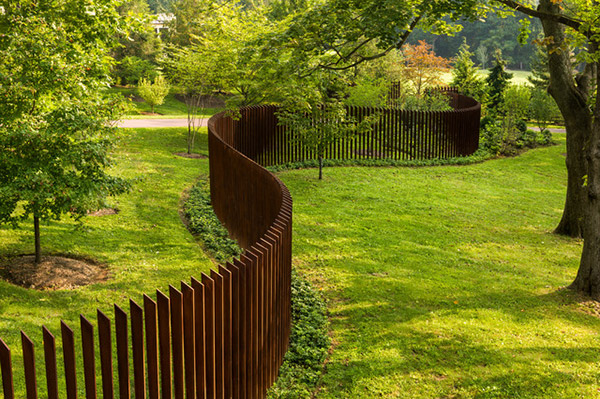Looking at the origins, materials and subliminal messages of boundaries
The origins of fences
The origin of the word “fence” comes in the XIV Century with the word fens, a short term for defense, protection. The Oxford Dictionary defines it as “a structure serving as a barrier, boundary or enclosure, usually made of posts or stakes joined together by boards, wire, or rails. It surrounds, separates, keeps away, it defends.”
The history of civilization is closely tied with the history of fences. It emerged from the notions of agriculture, family and property. Fences helped institutionalize the collective recognition of private property as a visual and open declaration of intention, a commitment to the land, a proprietor’s self-regard and responsibility.
But were fences used to bar access to a land or were they used to mark the land? As the dictionary states, and on first impressions, it is a structure serving as a barrier but when is an opaque sort of wall it works as signage. We make an interpretation rather than physical contact with it; we know we should not trespass it and we know that this portion of terrain belongs to someone. It has a symbolic meaning.
The Greeks were the first to use a fence. Although in Athens the land was kept based on social recognition, with no partitions, when they were outside of local boundaries, conquering territory in Asia Minor, the terrain was divided among themselves with partitions. Romans repeated the pattern. The fence was instrumental in these land appropriations and played a part in the domination-securing processes.
The evolution of fencing materials
The materials changed along the way: in the Bronze Age they used stone fences, a solid durable material; the Anglo-Saxons preferred worm fences, a zigzagging structure of rough wooden rails crossed at an angle, which did not require driving posts into the ground and was particularly labor and cost efficient. In Victorian housing, wrought iron grids were used with detailed organic elements, presenting a dichotomy of a strong solid element designed with such delicacy.
The human relationship with boundaries
Fences regulate our movement on the ground we live in which is in constant transformation, forming our dynamic society. It is a product of the struggle for control between humans, a technological solution we conceived to solve social conflicts, a symbolic expression of our conviction that we should have some kind of social control.
“Good fences make good neighbors” Robert Frost, Mending Wall, London, 1914
Fences can be the cause of unpleasant arguments between neighbors. As a social controller, the type of fence and the correct boundary between terrains are often the source of disagreements. A good design and a previous reasonable discussion about these boundaries can prevent it.
There are different cultures and therefore different notions of boundaries and privacy. The idea of an interior that extends its limits to the exterior of the yard is appealing for most inhabitants of a house. So they build a fence to secure the new limit. It can be opaque, made of wood, stone or metal; and it can be permeable, allowing visual contact with the other side.
A fence is not just a boundary. It doesn’t only divide but connect spaces, it’s a reminder that two spaces are standing next to each other; it directs movement and enhances the appearance of a space. The railings or balustrades are also a type of fence; it protects us from falling but it also allows us to give that extra step towards a limit that we figure dangerous.

Trollstigplatået, Norway by Reiulf Ramstad Architects
The design and the materials affect our personal reality and perception of an object that’s primary function is to bar and/or mark the land. So we turn this structure into a pleasant sculpture, we subvert its meaning creating visual and physical interaction, giving the illusion that we’re not being controlled.

Corten Cattails Sculptural Fence, Pennsylvania by Archer Buchanan Architects Photograph by Tom Crane